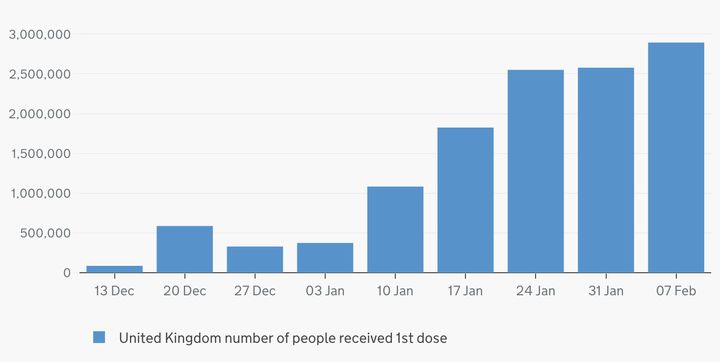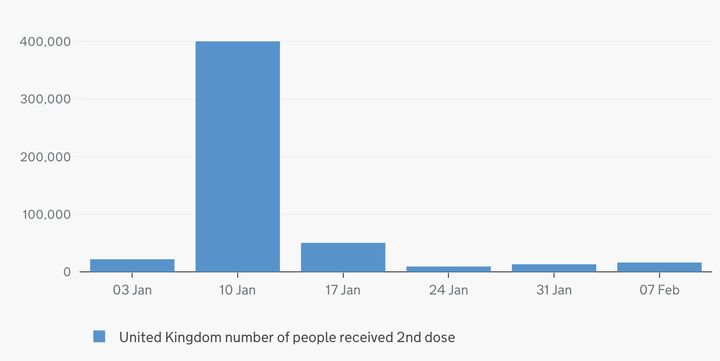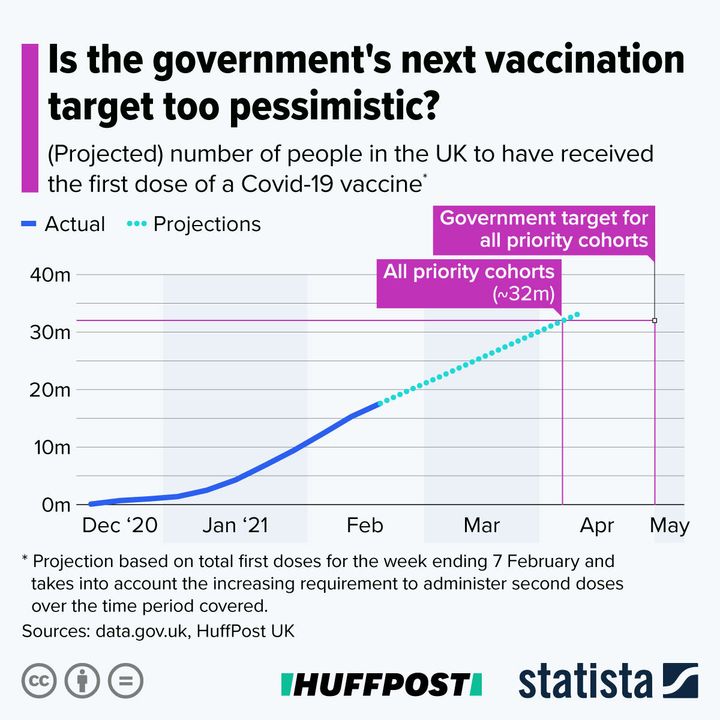There is no doubt that the UK is leading the way among the world’s biggest nations with its coronavirus vaccine rollout.
The target to give first doses to the 15m or so most vulnerable people was comfortably met on time and attention is now turning to the next phase of the vaccination programme.
Those next in line include all those aged between 50 and 70, as well as those aged between 16 and 64 with underlying health conditions which puts them at higher risk of serious disease and death.
It is thought to cover an additional 17m people, and it is hoped when these next groups are covered hospitalisations and deaths from Covid should be massively reduced.
Boris Johnson has set a target of May to give the first jabs to these people, who are in the remaining priority groups five to nine, as set out by the Joint Committee on Vaccination and Immunisation (JCVI).
But given the rapid pace of the vaccine rollout so far, this seems somewhat pessimistic.
This matters because the downbeat assumptions could allow the prime minister to announce a slower route out of lockdown, with jabs set to play a key role in decisions on when to lift restrictions.
Here’s why the statistics suggest that the UK could in fact vaccinate all those aged over 50 and all the most vulnerable by early April – well ahead of target.
How quickly is the UK currently vaccinating people?

In the week ending February 7, more than 2.8m people received their first doses, taking the total to 12.3m, and 16,156 had their second doses, according to the latest weekly figures on the government’s coronavirus dashboard.
As of February 14, 15.3m people had their first doses, according to daily data, suggesting that 3m people were jabbed for the first time last week.
The weekly vaccination rate has also steadily increased every week since the programme started in mid-December.
So how many jabs can we do by May?
Even if the rate of vaccinations does not speed up any more, it means the UK could administer another 30.8m doses by May 2.
This is massively beyond the target to give first doses to 17m people by that date.
So could we vaccinate everyone in the priority groups by Easter?
Vaccinating at the current rate of 2.8m jabs a week would mean 19.6m people could be immunised by April 4 – Easter Sunday.
Ah, but what about second doses?

It is true that second doses will slow down the vaccination programme, assuming current rates remain the same.
The JCVI and the government decided to delay second doses to 12 weeks after the first jab, choosing instead to prioritise offering more people the protection given by a single dose.
It means that everyone vaccinated up to January 17 will need to receive their second dose by April 4 (12 weeks later).
This means nearly 4.3m will need their second dose by April 4.
So that will slow things down and explains the pessimistic May target, right?
Well, not quite.
Already, 539,630 people have received their second doses, meaning around 3.7m more will need them by April 4 to meet the 12-week turnaround.
On top of the 2.8m people we are currently vaccinating each week, 16,156 are also getting second doses weekly.
If that continues at the current rate it means an additional 113,092 people will get their second doses by April 4, regardless of what happens with first doses.
To ensure all the people who need their next jab get it by April 4, that will mean diverting some 3.6m jabs away from first doses to second doses.
It still means the UK should be able to administer 15,968,593 first vaccine doses by April 4 if current vaccination rates continue.
This is a shortfall of about a million regarding the target to cover all over-50s and the clinically vulnerable.
And it means the target is likely to be met some time in the week beginning Easter Monday, based on current vaccination rates.

So why is the government seemingly so pessimistic?
Vaccines minister Nadhim Zahawi highlighted the impact of second doses on the speed of the rollout on Tuesday.
He told LBC: “So you’ve got first dose, and then also you’re starting second dose. You’re doing both.
“That’s part of the challenge.
“Then of course vaccine supply at the moment remains finite.”
But he admitted that supply was “becoming much more stable” and pointed out that the UK is expecting the delivery of Moderna vaccines for the first time in March.
In total the UK has ordered 17m doses of the Moderna jab, which has been approved by regulators, although it is not clear how many will be available in March.
The prospect left Zahawi struggling to stick to the government’s current cautious approach
“I’m confident we’ll hit that target and then actually go beyond it because we’ve then got to deliver the vaccine to the adult population,” he admitted of the May target.
So why is the government seemingly so pessimistic?
Vaccines minister Nadhim Zahawi highlighted the impact of second doses on the speed of the rollout on Tuesday.
He told LBC: “So you’ve got first dose, and then also you’re starting second dose. You’re doing both.
“That’s part of the challenge.
“Then of course vaccine supply at the moment remains finite.”
But he admitted that supply was “becoming much more stable” and pointed out that the UK is expecting the delivery of Moderna vaccines for the first time in March.
In total the UK has ordered 17m doses of the Moderna jab, which has been approved by regulators, although it is not clear how many will be available in March.
The prospect left Zahawi struggling to stick to the government’s current cautious approach
“I’m confident we’ll hit that target and then actually go beyond it because we’ve then got to deliver the vaccine to the adult population,” he admitted of the May target.
Graphic provided by Statista

